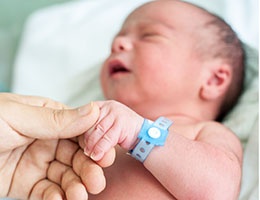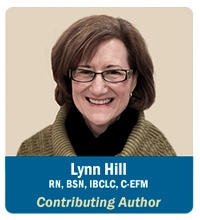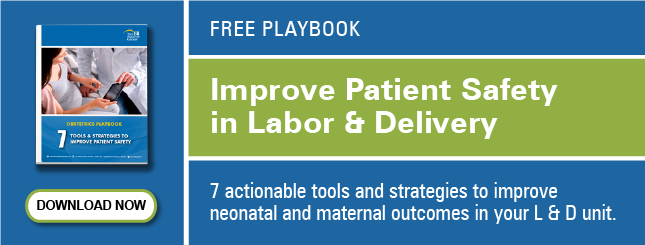
[3 MIN READ]
Correct patient identification has long been at the top of the list regarding safety.
A recent TSG article by Dr. Tom Syzek entitled “Medical Errors, Communication, Teamwork and End of Life: Lessons from Angola” speaks to the importance of correct patient identification and the safety implications surrounding it. This article dovetails nicely with the new 2019 Joint Commission National Patient Safety Goal (NPSG) regarding newborn identification, so I thought this would be the perfect opportunity to keep the conversation relevant and on-topic by addressing this new NPSG.
Hospitalized newborns are a vulnerable population at considerable risk for misidentification. Several unique features of the newborn population lead to misidentification:
- They all are born with similar birth dates and similar medical record numbers.
- Multiples will have identical surnames and be hospitalized at the exact same time.
- They are not able to speak, so they cannot participate in confirming their identities.
- They lack the distinguishing physical attributes and characteristics that are specific to the adult population.
Furthermore, well-known misidentification errors such as wrong patient/wrong procedure have resulted in many errors, including:
- Providing two vaccines to the same infant
- Wrong infant being circumcised
- Feeding a mother’s expressed breastmilk to the wrong newborn
- Giving a breastfed infant formula or a mother breastfeeding the wrong infant
All these errors have the potential to cause patient harm and parental distress. A reliable identification system is necessary to prevent these types of serious errors and prevent harm to the newborn; hence, the birth of this safety initiative.

The need for updated and improved newborn identifiers was recognized by the AAP and other leaders in the field of safety. Gray et al. found that similar medical record numbers followed by similar or identical surnames made up the bulk of misidentification errors. Heightened awareness to this issue provided the impetus for much needed scrutiny of current practices. After research of the literature, public review, and engaging discussion the safety leaders developed the National Patient Safety Goal (NPSG.01.01.01).
Effective January 1, 2019, all hospitals caring for newborns will be required to use at least two patient identifiers when providing care, treatment and services to newborn infants.
Examples of methods to prevent misidentification as cited by the NPSG may include the following:
- Distinct naming systems could include using the mother’s first and last names and the newborn’s gender (for example: “Smith, Judy Girl”; or “Smith, Judy Girl A” and “Smith, Judy Girl B” for multiples).
- Standardized practices for identification banding (for example, two body-site identification and barcoding).
- Establish communication tools among staff (for example, visually alerting staff with signage noting newborns with similar names). (NPSG.01.01.01)
Safe Practices for Infant Identification
- Utilize the 2019 NPSG guidelines for identification.
- Focus on standardized practices with consistency.
- Use barcoding when available.
- Ensure that information on ID band is legible.
- Place newborn ID bands on two extremities; preferably wrist and opposite ankle.
- Ensure that ID bands are secure so they will not become loose or lost in blankets and linens.
- Double check two identifiers prior to initiating documentation into the electronic medical record.
- Instruct parents on the importance of maintaining the ID bands.
- Replace ID bands that are destroyed, damaged, inaccurate or incomplete.
- Use dual RN ID confirmation prior to meds, treatments and procedures.
- Use a time-out before treatments/procedures as an opportunity to again confirm patient identification.
- Parents can and should assist in the identification process, especially at the time of hospital discharge.
- Standardize an alert system that identifies similar-sounding names; for example, a flag on the chart stating “similar name patient,” a color-coding alert, etc. Alert team members, charge nurse, etc., of the similar names and make sure that this information gets passed along from shift to shift.
Vigilance for accurate patient identification is a quality and safety issue that should be embedded into our daily hospital routines. The busyness of hospital routines such as infant feedings, circumcision, cardiac screens, hearing screens, bilirubin assessment and lab draws should not undermine the importance of correct patient identification. Everyone working with newborns is responsible to ensure that misidentification does not happen and that safety is always maintained.
Resources
- Gray JE, et al. Patient misidentification in the neonatal intensive care unit: Quantification of risk. Pediatrics. 2006;117:e43-e47.
- https://www.jointcommission.org/assets/1/18/NEW_Requirement_for_Distinct_Identification_for_Newborns.pdf
- https://www.jointcommission.org/assets/1/18/R3_17_Newborn_identification_6_22_18_FINAL.pdf
- Healthcare Risk Management. Patient ID a top source of error; newborns high risk. Healthcare Risk Management. 2016;38:133-144.
- Wallace SC. Newborns pose unique identification challenges. Pennsylvania Patient Safety Advisory. 2016;13: 42-49.


